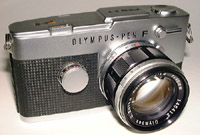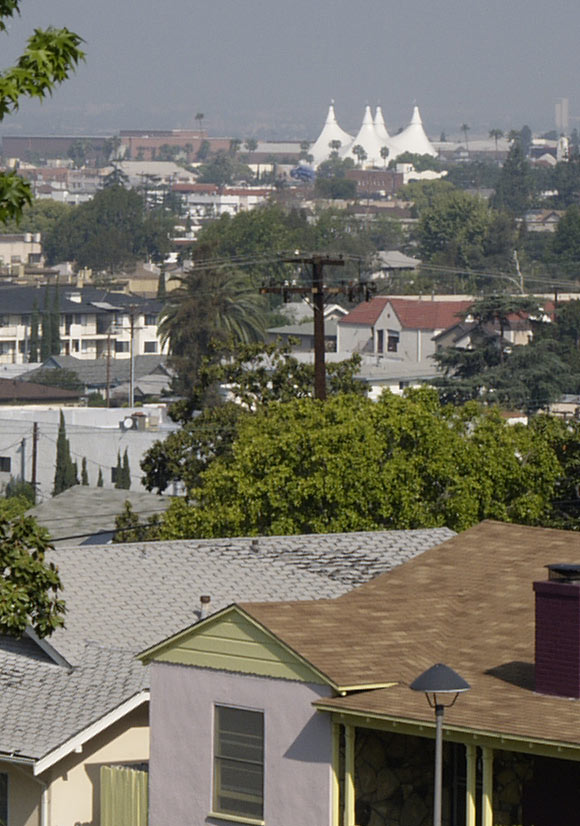|
 Olympic Achievement Olympic Achievement
How could
I have been more excited? A dSLR in a fixed-chip-size 4:3 format?
The numbers
that describe the format aren't particularly helpful, unless
you think of the fixed size of the chip as being two times the
dimensions of a 2/3-inch chip, but even that's not quite it.
Chip nomenclature
is old. So old that it really only works for vidicon tubes from
the 1950s and 60s. Today's 2/3-inch chips are really about 6.7
x 8.9mm, so the link to the inch thing is way off, as far as
comparing the two ideas. The 4:3 chip is about 13.5 x 18 mm of
active image sensors, potentially making the camera smaller,
with smaller, lighter interchangeable lenses.
 Olympus has a history
of shrinking cameras. Long, long ago in a galaxy far away, they
produced a half-frame 35mm called the Pen F. So small that it
didn't have a pentaprism roof on it. It looked like a rangefinder
camera with a protruding lens. But no viewfinder port pierced
the face of its body. Several lenses fleshed out the system and
it was cute indeed. Also, largely ignored by the public who saw
those half-frame shots and turned up a blind nose to the idea.
Still, it WAS cute. Olympus has a history
of shrinking cameras. Long, long ago in a galaxy far away, they
produced a half-frame 35mm called the Pen F. So small that it
didn't have a pentaprism roof on it. It looked like a rangefinder
camera with a protruding lens. But no viewfinder port pierced
the face of its body. Several lenses fleshed out the system and
it was cute indeed. Also, largely ignored by the public who saw
those half-frame shots and turned up a blind nose to the idea.
Still, it WAS cute.
I hoped
the "smaller, lighter, sweeter dSLR" thing was in store
for the 4:3 format, but only part of that came true in the E-1.
Its lens
mount sits a few millimeters closer to the image plane than other
dSLRs, but Nikon lens mounts are several millimeters smaller
in diameter and Canon mounts are only a few millimeters larger
in outside diameter.
The E-1
is about the same size as a Digital Rebel or D70 Nikon. It is,
however, one of the finest built dSLRs you could touch. And the
price is about the same as the 10D from Canon or the D100 from
Nikon. $2300 gets you a body and lens at list price. Deals can
be had.
One big
mental advantage: 4:3 camera lenses use an exact 2:1 crop or
magnification factor for estimating the viewing angles of optics.
E.g; 50mm in E-1 speak = 100mm in 35mm camera speak. Olympus
makes a lovely 50-200 f/2.8-3.5 zoom that behaves like a 100-400mm
f/2.8-3.5 zoom on a 35mm camera, if you could find such a beast.
Obviously
Olympus has put a major engineering team into the E-1 and its
image quality competes favorably with the 6-megapixel cameras
in this class. With a maximum frame of 2560 x 1920 pixels, it
occupies the center 95% of useful space from those 3:2 aspect
cameras' sensors, pixelwise.
Check it
out. The reality is that 6M sensors have their extra pixels in
relatively less-used "ears" on either side of the 3:4
aspect center area (the 6M frame here is 3072 x 2048 from a Digital
Rebel. Nikon's 3008 x 2008 6M image is a micro-skosh smaller):

Ask yourself,
"When was the last time I saw a picture in a magazine or
book that was 3:2 aspect?" and when you can't remember one,
join the club. Most 35mm and 3:2 aspect shots trim something
away on their way to journalism, museum display, billboards,
fashion magazines, calendars, brochures or even prints. Aspect
ratio of an 8x10: 0.8:1. Aspect ratio of a 5x7: 0.71:1. Aspect
ratio of a 3:2: 0.67:1. Nobody wins it all, except 4x6 prints.
I can't
rave about the build quality of this camera, that and its ergonomic
design touches add up to one fine system. Albeit a tad on the
SUV side, not the sports car I'd hoped to see. Zooming is a pleasure
with collars on the lenses that stay where you leave them and
all the lenses are internal focus so they work well with tulip
lens shades and polarizing filters.
The buttons
are where you need them to be and it even has things like two
scroll wheels to expedite button+scroll option selections.
Autofocus
has three sensitive zones, clearly marked. But they're so close
to each other that the idea is moot, even though you can select
any one or all at which time the one seeing the closest subject
dominates.
White balance
presents a professional color temperature selection from 3000°
K to 7800°K. As you select these, bold graphics present the
choice on the monitor with icons for things like sun, flash,
clouds, etc.
Images
made by the E-1 look soft, at first, on your computer screen,
but there's a well-considered reason for that. Olympus has avoided
sharpening artifacts, never allowing the camera to potentially
ruin images with in-camera over-sharpening that you would never
be able to see as you reviewed images in the field. You can perk
sharpening up to +2 for results comparable to other dSLRs (and
I do). Beyond that, put the shots in your editing program where
greater control can be better applied.
High in-camera
sharpening is not something that fosters better looking pictures,
except for snapshooters who don't edit and tweak their results
and usually print small images. It's easy to print images up
to the largest full-frame size that tabloid printers allow, in
the 13 x 19 inch range (330 x 443mm). The E-1 is definitely geared
toward professional users.
Images
are also slightly dark, compared to other digicams set for the
same ISO. Probably so the Oly pix can hang onto more highlight
detail (reviewers have noticed this quite a bit).
Here's
an example compared (rollover) with a Canon Digital Rebel shot
made at the same time. It's difficult to get the two to cover
the same "pixel area" so a tad of size change shows
here.

Exposure
is perhaps 1/2 stop lower and the distant circus tents show how
much more highlight detail shows at the original, unaltered brightnesses.
You can adjust either image in Photoshop to look like the other,
but I favor the brighter look of the Canon.
You could
set the E-1 to EV+0.5 if you wish (there's even a menu item to
select between 0.5 EV and 0.3 EV exposure increments), just as
you can perk up the sharpening. The Oly image here used +2 sharpening
and the Canon used default 0 sharpening. At this setting I think
I'm seeing just a tad better per-pixel detail with the Oly.
ISO 100,
Program Exposure Mode, and both with a squinch of f/9.
The on-camera-body
WB on the E-1 is wonderful. You point your lens at anything white
and press the button. The camera looks only for the brightest
subject matter and analyzes the color neutrality of that. A reference
image shows up on the monitor and pressing the OK button locks
the Manual WB to that reference. You can store up to four custom
settings this way. Auto WB uses a separate sensor on the camera
to hunt for clues as to the ambiant lighting's color temperature.
While other cameras look at the picture for clues as to the right
seeing for AutoWB, the Oly is looking for mixes of infrared and
visible light to sort things out.
The camera
gets an A, and the 14-54mm Zuiko lens gets a B+ to A. Points
were subtracted for slight chromatic aberration that reversed
itself over the zoom range.
Extra credit
goes to this camera for having such great ergonomics, build and
operation qualities, deep and feature rich menus and options
(rear shutter sync, for instance, if you wish). More for the
great tripod socket, monitor protector and viewfinder shutter.
Tiny demerits
for slightly too complex latches on the CF card and Battery compartment
doors, and one big point off for no flash on board. Yep, you
have to take one with you, separately. Sigh. Gotta say it though,
the optional smart flash FL-50 from Olympus is one killer unit.
Full intelligent TTL, full zoom, full angle AND head rotation
for bounce in ANY direction of your choice, long distance focus
light, focal lengths geared to 4:3 cameras, ISO 25-3200, and
AA battery power--and still about the size of most other external
units.
In a perfect
world this camera would have more focus sensors, more extensive
in-viewfinder display, a built-in fill flash and easy CF card
access.
At the
price, though: Wow!
Read the
news from the digital camera testers:
Imaging
Resource: Here.
DP Review:
Here.
Steve's
Digicams: Here.
DP Now:
Here.
  Get
the eBooks. We
have a secure order page that will allow ordering the Nikon and
Sony eBooks. Or you can call direct and order from the publisher
by phone or FAX. Get
the eBooks. We
have a secure order page that will allow ordering the Nikon and
Sony eBooks. Or you can call direct and order from the publisher
by phone or FAX.
Phone:(310) 475 2988 (M-F
9-5 Pacific Time)
FAX (310) 475 9486 (24hrs).
All components,
text and images © 2004 Peter iNova.
All rights reserved. Do not reprint. Do not link to images.
Reprinting except for newsworthy mention and brief quotes are
by permission only
|


 Olympic Achievement
Olympic Achievement Olympus has a history
of shrinking cameras. Long, long ago in a galaxy far away, they
produced a half-frame 35mm called the Pen F. So small that it
didn't have a pentaprism roof on it. It looked like a rangefinder
camera with a protruding lens. But no viewfinder port pierced
the face of its body. Several lenses fleshed out the system and
it was cute indeed. Also, largely ignored by the public who saw
those half-frame shots and turned up a blind nose to the idea.
Still, it WAS cute.
Olympus has a history
of shrinking cameras. Long, long ago in a galaxy far away, they
produced a half-frame 35mm called the Pen F. So small that it
didn't have a pentaprism roof on it. It looked like a rangefinder
camera with a protruding lens. But no viewfinder port pierced
the face of its body. Several lenses fleshed out the system and
it was cute indeed. Also, largely ignored by the public who saw
those half-frame shots and turned up a blind nose to the idea.
Still, it WAS cute.
 Get
the eBooks
Get
the eBooks